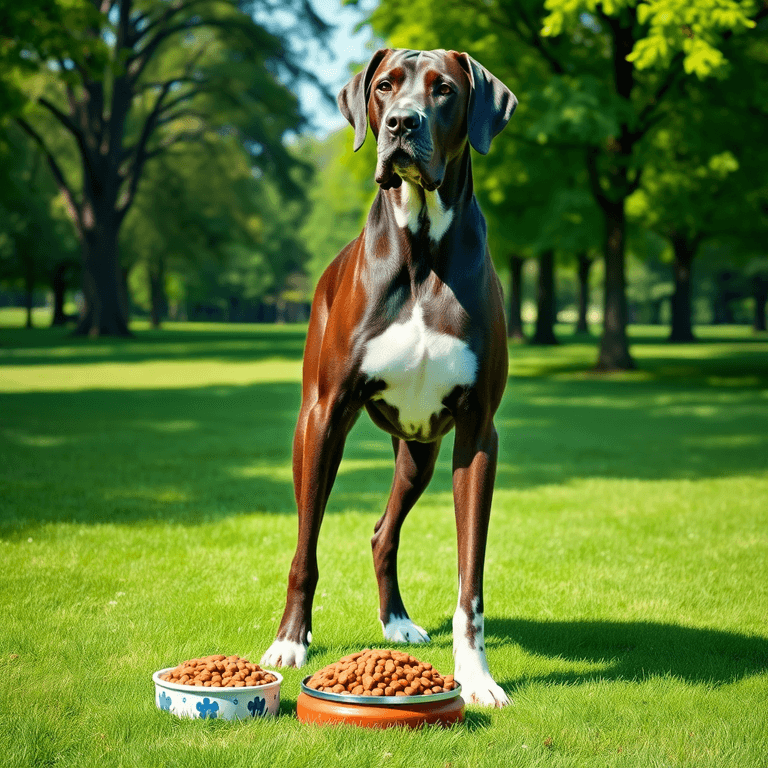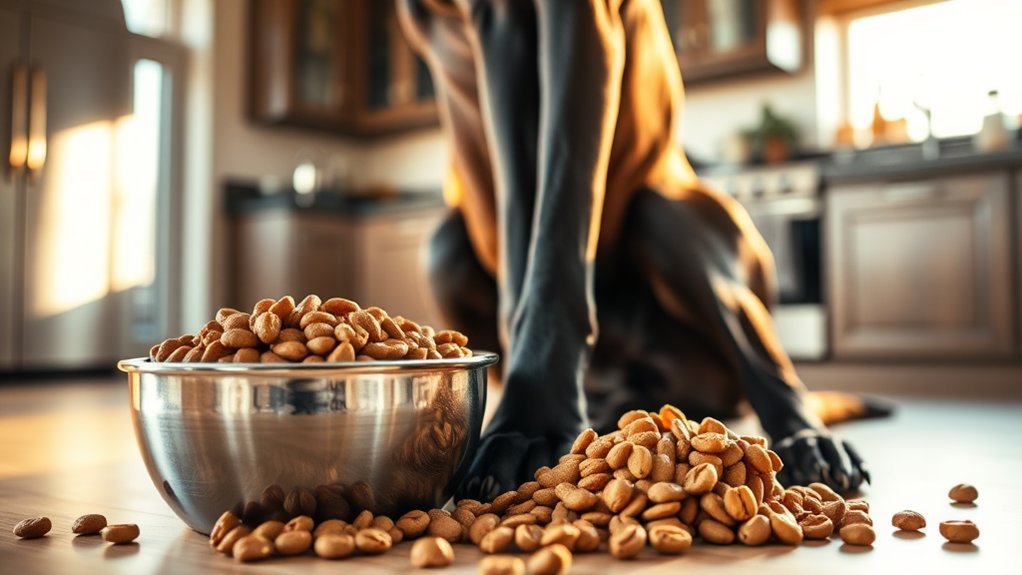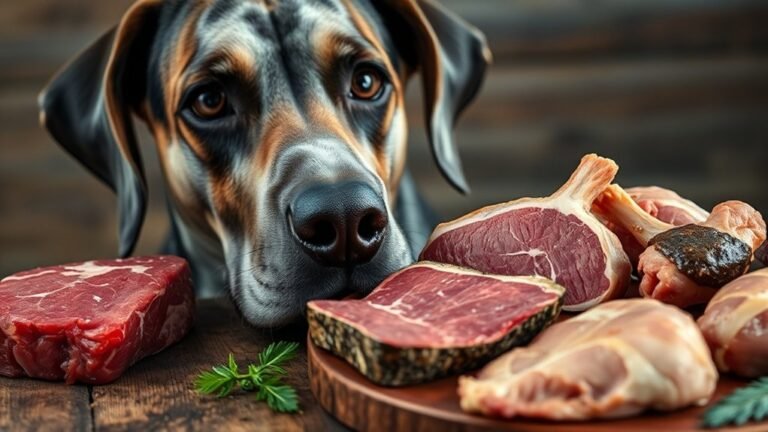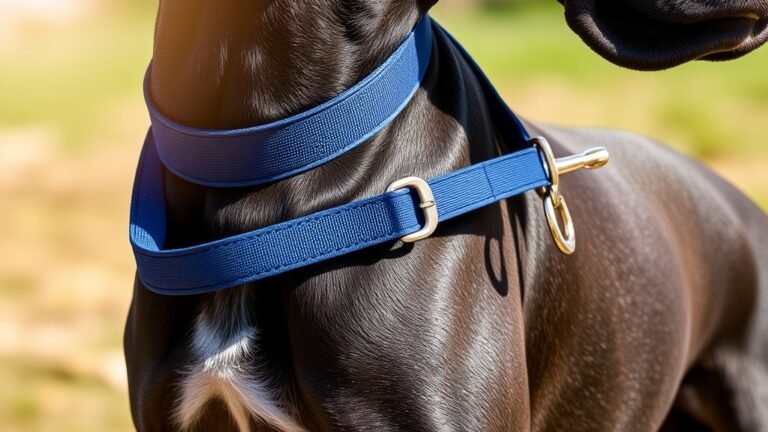Best Dog Food for Great Dane to Gain Weight

Best Dog Food for a Great Dane to Gain Weight
So, you have a skinny Great Dane friend who needs to put on some weight? Trust me, I’ve been there! When I was younger, I looked like a walking coat hanger with legs. Not a good look for us gentle giants!
Here’s the scoop from someone who knows – you need dog food that’s packed with calories. Look for the good stuff that has 450-500 calories in every cup. That’s like hitting the doggy jackpot! The protein should be between 26-30%. Think of protein as the muscle-building superhero in your kibble.
My personal favorites? Hill’s Prescription Diet makes my tail wag, Royal Canin Giant Breed knows how to treat us big guys right, and Eukanuba Large Breed is pretty tasty too. These foods contain all the essential nutrients we need, such as calcium and phosphorus, to keep our bones strong. Plus glucosamine – which sounds scary but helps our joints feel great!
Now, here’s the essential part that could save your life: we need to eat 3-4 smaller meals instead of wolfing everything down at once. Great Danes can develop a condition called bloat, and trust me, you don’t want that! Split up those 2,500-4,000 daily calories throughout the day.
Watch the scale each week; gaining 1-3 pounds is ideal. Any more and you might be getting chunky instead of healthy!
Woof! Now go get some good grub!
Nutritional Requirements for Great Dane Weight Gain
We need WAY more food than those tiny Chihuahuas next door. My human learned that I need exceptional food with lots of calories packed into each cup – about 450 to 500 calories per cup! That’s like eating a really dense energy bar instead of plain crackers.
Now, let me tell you about protein – it’s my best friend! I need at least 26 to 30% protein in my diet to build the massive muscles I want. Think of protein as the building blocks for my super-strong body. The best protein comes from real meat, not synthetic alternatives. Trust me, my taste buds know the difference!
But here’s the tricky part – too much fat makes my tummy feel yucky. My food should have no more than 18% fat, or I might get an upset stomach. And nobody wants a sick Great Dane – we’re drama queens when we don’t feel good!
My bones need special attention too. There’s this thing called calcium and phosphorus that keeps my skeleton strong. It’s like having the right recipe for building the perfect giant dog frame. Maintaining appropriate calcium levels is crucial for preventing skeletal issues as I grow!
The food I eat needs to be super easy to digest – at least 85% easy! This means my body can use all those good nutrients instead of just passing them through.
Oh, and here’s a pro tip from this big guy – I eat three smaller meals instead of one giant bowl. This keeps my stomach happy and prevents something scary called bloat. Plus, it gives me three exciting meal times instead of just one!
Top Dog Food Brands for Great Dane Weight Management
Great Danes require specialized food to stay strong and healthy, not just chunky and slow.
My human friends at the vet clinic recommended some excellent dog food brands that help Great Danes like me feel our best. There’s this stuff called Hill’s Prescription Diet, Royal Canin Giant Breed, and Eukanuba Large Breed.
The smart vets did tests and found out that these foods work for big dogs like me! These foods contain a high amount of protein (approximately 28-32%, which is a lot for me to count, but my human says it’s good).
They also have the right amount of fat and vitamins that make my tail wag and my muscles strong. It’s like getting a perfectly balanced meal every time! Additionally, these brands often include joint-supporting nutrients to help me maintain an active lifestyle.
But wait! Don’t rush to the store just yet. You need to consult with the vet first, as every Great Dane is unique. Some of us need more food, some need less.
The vet will assess our weight and determine the ideal plan. The best part? These foods taste great AND they won’t upset my tummy. Trust me, nobody wants a Great Dane with a bellyache!
Feeding Strategies and Portion Guidelines
Listen up, because I’m about to spill the kibble on how to feed us gentle giants properly. First off, we need WAY more food than your tiny Chihuahua friend – I mean, look at me! I’m a miniature horse with floppy ears.
Here’s the deal: we need our meals split up into smaller portions throughout the day. Why? Well, if we eat one giant meal, our stomachs can get twisted up like a pretzel – and trust me, that’s no fun for anyone. Nobody wants a sick Great Dane on their hands!
My human needs to count out the right amount of calories for me each day. I know, I know – math is hard when you’re distracted by my adorable face begging for treats. But it’s super important! Too much food and I’ll look like a furry bowling ball. Too little and I’ll be hangry (that’s hungry + angry, in case you didn’t know).
Keep an eye on my weight because us Great Danes grow faster than weeds in summer. One day I’m knee-high, the next day I’m stealing food off your counter!
My bones need just the right amount of nutrition to grow big and strong without becoming misshapen. It’s also essential to avoid high-protein puppy foods that can lead to skeletal disorders as I grow.
Daily Portion Requirements
How Much Food Do I Need? A Great Dane‘s Guide to Getting Fed Right
My human friends always ask how much food I need every day. Well, grab a snack and let me explain (but not too big of a snack – that’s MY job!).
Us Great Danes are pretty special when it comes to eating. We’re not like those tiny dogs who nibble on a few kibbles and call it a day. Nope! We need way more food because our bodies work differently. Think of us like really tall basketball players – we need more fuel to keep going!
My human has to count something called calories for me. I need approximately 2,500 to 4,000 calories every day. That’s like eating ten hamburgers! If I’m too skinny (which happens sometimes), I need even MORE food – about 20 to 30% extra. My human gets out a calculator and does math just to feed me. I feel pretty important!
Here’s something super important, though – I can’t eat all my food at once, even though I really want to. That would be like you trying to drink a whole gallon of milk in one gulp. Not good! My stomach could get twisted up, which is scary and dangerous. So my humans give me 3 or 4 smaller meals throughout the day instead.
My favorite part is when they use the kitchen scale to measure my food. It beeps and everything! They don’t just scoop it with a cup because different foods weigh different amounts. It’s like how a cup of feathers weighs less than a cup of rocks.
Every week, my humans check to see if I’m gaining weight or staying too thin. Then they change how much food I get. If I need more food, they don’t give me tons of extra all at once – that would upset my tummy. Instead, they add just a little bit more each week until I’m the perfect Great Dane size! This helps avoid potential health risks associated with obesity in Great Danes.
But with the right amount of food spread out during the day, I stay happy, healthy, and ready for belly rubs!
Multiple Meal Scheduling
My Guide to Not Eating Like a Vacuum Cleaner
Let me tell you about this scary thing called bloat that can happen to us big dogs when we eat too fast or too much at once.
So here’s what my humans figured out – instead of giving me one giant bowl of food that I could inhale in thirty seconds, they split my meals into three smaller ones throughout the day. I know, I know, it sounds like torture at first, but hear me out!
Now I get breakfast, lunch, and dinner just like a fancy human. Each bowl has about 2-3 cups of food, which is way less overwhelming than my old giant mountain of kibble. The best part? I taste my food now instead of just making it disappear like magic.
My humans space out my meals every 6-8 hours, which gives my belly time to digest everything properly.
And get this – after each meal, I’ve to chill out for about an hour before I can go running around the yard. Trust me, I learned this rule the hard way when I tried to play fetch right after dinner once. Not fun.
The cool thing is that eating more slowly helps my body absorb all the good stuff from my food. Additionally, I no longer experience those annoying hiccups from swallowing too much air. My tummy feels way better, and I’m not walking around looking like I swallowed a basketball. And remember, early training is just as important for establishing good habits around mealtime.
Gradual Amount Adjustments
My Human Wants to Change My Food Amounts – A Great Dane‘s Guide
Woof! Let me tell you about what happens when my human decides I need more food.
When my human wants to give me more food, they can’t just dump a huge pile in my bowl overnight. That would make my tummy very upset, and nobody wants that mess! Instead, they’ve to be sneaky about it and change my food amounts bit by bit over 7-14 days. It’s like they’re trying to trick my stomach into not noticing.
Every 2-3 days, my human adds about 10-15% more food to my bowl. That’s like getting an extra few kibbles each time. They oversee me to make sure I’m not getting too chunky or too skinny. They also check my poop – yeah, I know, gross! But apparently that tells them if my belly is happy.
My digestive system needs time to adjust to eating more food. If my human gave me too much too fast, I might get the runs or throw up. Nobody wants that, especially not my human who’s to clean it up!
The best part is when they give me food that has more calories packed into each bite. That means more energy without stuffing my already huge stomach until it feels like it might pop. High-biological-value proteins are often utilized in these calorie-dense diets to support my growth.
During this whole process, my human weighs me every week. If I’m too skinny, they want me to gain 1-2 pounds each week.
Sometimes my poop gets loose during food changes. When that happens, my smart human keeps my food the same for a few extra days until my tummy feels better. They write down everything about how I’m doing so they know exactly how much food makes me perfect!
Essential Nutrients for Joint and Bone Health
Woof! Let me tell you about the three most important things my humans need to know to keep my giant bones and joints happy and healthy!
First up is calcium – and boy, do my humans get confused about this one! They think because I’m going to be HUGE (like, really huge), I need tons of calcium. Wrong! Too much calcium can interfere with my growing bones and cause me to walk with a funny gait. My humans need to give me just the right amount – not too much, not too little. It’s like Goldilocks, but for dog bones!
Next are these special joint supplements that sound super fancy but help keep my joints bouncy and smooth. Since I grow faster than a weed in summer, my joints need extra help to stay strong. These supplements are like little bodyguards for my joints while I’m shooting up like a furry skyscraper.
Finally, there’s protein – the good stuff that helps build my bone foundation. But here’s the tricky part: I need enough protein to build strong bones, but not so much that it makes me grow too fast and hurts my skeleton. It’s all about finding that sweet spot where my bones can grow big and strong without any ouch-y problems. Responsible breeding practices are also essential to ensure that I have the best chance for a healthy life.
Getting all three of these right means I’ll be able to run, play, and give the best giant dog hugs for years to come!
Calcium Control Guidelines
So here’s the deal – I know you love me and want me to grow up big and strong. But here’s a secret: too much calcium in my puppy food can make my bones grow all wonky! I know, I know, it sounds backwards.
When I’m a growing puppy, my food should have calcium levels between 1.0% and 1.8%. Think of it like Goldilocks – not too much, not too little, but just right! My body is already quite efficient at absorbing calcium from bone meal and calcium carbonate. These are way better than getting it from plants (and honestly, I’d rather have a good meaty bone anyway).
Here’s something super important: if there’s too much phosphorus compared to calcium in my food, my bones get confused about how to grow appropriately. The perfect balance is like a see-saw that isn’t tilted too far in either direction.
Please don’t give me extra calcium pills or supplements on top of my puppy food! I know you mean well, but my specially-made large breed puppy food already has everything I need. Excessive calcium disrupts the formation of my bones, and trust me, nobody wants a Great Dane with wobbly joints or hip problems.
During my puppy months, just keep an eye on what I’m eating. My bones are working incredibly hard to grow me into the gentle giant I’m meant to be, and the right amount of calcium helps ensure I stay healthy and happy for all our future adventures together! Remember, early socialization also plays a key role in my overall development, so let’s make sure I meet lots of new friends!
Joint Support Supplements
I’d like to discuss ways to keep these large joints of mine happy and healthy.
You know, being this big and awesome comes with its share of challenges. My joints work really hard every day, carrying around all this magnificent Great Dane body! That’s why my humans give me special supplements to keep my joints feeling good.
The main superheroes in my supplement bowl are glucosamine and chondroitin sulfate. These fancy-named helpers are like little repair crews that keep my cartilage firm and bouncy. They also help alleviate the slippery feeling in my joints, allowing me to move around without creaking like an old door.
Then there are these things called omega-3 fatty acids – EPA and DHA if you want to get technical about it. They’re like tiny firefighters that put out inflammation in my joints. Pretty cool, right?
My humans also give me something called MSM. I can’t pronounce the long name, but it helps build the stretchy stuff that holds my joints together. Additionally, it helps protect against the harmful substances that can damage my joints.
Here’s the most important thing, though – and I can’t stress this enough – always consult your vet before giving any supplements. Every Great Dane is different, and what works for me mightn’t be right for your big buddy. Your vet knows best about what dose is safe and what’ll work with everything else your dog needs.
Additionally, my diet plays a crucial role in supporting my overall health, including joint health, as certain food allergies in Great Danes can exacerbate joint problems. Trust me, taking care of our joints now means more years of playing, running, and being the gentle giants we were born to be!
Protein for Development
My Big Dog Body Needs Good Protein!
Woof! Let me tell you about protein – it’s like the super fuel that helps us Great Dane puppies grow into gentle giants! My body uses protein like tiny building blocks to make my muscles and bones super strong.
When I was just a little puppy (well, little for a Great Dane!), my human made sure I got plenty of high-quality protein. The best stuff comes from yummy chicken, tasty salmon, and something called lamb meal. These foods have all the special ingredients my growing body needed – kind of like having all the right puzzle pieces!
Here’s the scoop on how much protein us Great Danes need: When I was a puppy, I needed food that was about 22-24% protein. Now that I’m all grown up and huge, I only need about 18-20% protein to maintain my muscles’ appearance. It’s like the difference between building a house and just keeping it.
Getting the right amount is super essential for us to big dogs. If I didn’t get enough protein as a puppy, I’d have grown up weak and wobbly – no good for a dog who’s supposed to be tall and strong!
However, consuming too much protein can cause us to grow too quickly, which can harm our joints and bones. Nobody wants a gimpy Great Dane! Additionally, it’s crucial to ensure that the protein sources are of high quality to support joint and bone health as Great Danes are prone to certain genetic conditions.
Key Ingredients to Look for in Weight Gain Formulas
Hi there! I’m a Great Dane, and let me tell you – I need A LOT of food to get big and strong! When my humans choose food to help me gain weight, they look for some pretty important things.
First, I need a ton of calories because I’m going to be huge! My diet should include good carbs, such as brown rice and sweet potatoes. These give me energy all day long without causing my blood sugar to spike. Think of it like eating oatmeal instead of candy – it keeps me going longer!
The protein is also vital. I need real meat, such as chicken, salmon, or lamb, as the first ingredient on the label. This helps me build strong muscles instead of just getting fat. Nobody wants a pudgy Great Dane – we’re supposed to be tall and lean!
My joints require special care since I grow so quickly and become so large. Fish oil with omega-3 fatty acids helps keep my joints healthy. Plus, I need glucosamine and chondroitin – they’re like vitamins for my joints and bones.
Sometimes I’ve trouble digesting all this food (my tummy is sensitive!), so I need special enzymes and good bacteria to help break everything down. This way, I can use all those good nutrients.
Here’s something important – my food can’t have too much calcium! Too much can actually hurt my growing bones. Great Danes like me grow for a really long time, so we need just the right amount of minerals to stay healthy.
Trust me, the right food makes all the difference in helping me become the gentle giant I’m meant to be!
Feeding Schedule Recommendations for Underweight Great Danes
My Feeding Schedule – By One Hungry Great Dane****
Hey there! I’m a Great Dane who was pretty skinny for a while, but now I’ve got the best eating plan ever. Let me tell you about it!
Instead of eating only twice a day, like most dogs, I get to eat three or four times every day. Can you believe it? It’s like Christmas morning over and over! My humans have divided up all my food into smaller bowls, which is quite clever. This way, my tummy doesn’t get too full all at once, and I can use all the good stuff in my food better.
Smaller, more frequent meals help my big tummy digest better and absorb all the good nutrients without getting too stuffed!
I eat in the morning when I wake up, then again around lunchtime, and then early dinner. Sometimes, I even have a late snack. My meals are spaced out every four to six hours, which gives me something to look forward to throughout the day.
The best part is that everything happens at the same time every day. My stomach has gotten really good at knowing when food time is coming. My humans say this helps my body work better, and honestly, I just love having a schedule. No more wondering when my next meal is coming!
They weigh me every week and check on my progress. If I need more food, they give me bigger portions. If I’m doing great, they keep things the same. They don’t just leave food out all day because then they can’t tell how much I’m eating.
The timing also keeps my tummy safe from twisting, which can happen to big dogs like me. Additionally, I’m finally reaching a healthy weight! Being a well-fed Great Dane is pretty awesome.
Supplements to Support Healthy Weight Gain
Hey there, fellow pups and humans! So, my vet says I need to put on some pounds because apparently being a skinny Great Dane isn’t cool. Mom and Dad are already feeding me tons of food, but sometimes us big dogs need a little extra help – kind of like how humans take vitamins!
First up is something called omega-3 fatty acids. These fancy fish oils make me super hungry (which is fantastic!) and help my body stop being all cranky and inflamed. When my tummy feels good, I can absorb all those yummy nutrients much better.
Then there are enzymes that aid in digestion. Think of them like tiny helpers that break down my food so my belly can use every bit of it. Some of us Great Danes have sensitive stomachs, so these little guys are like having a food processing team in there!
My favorite supplement is protein powder! It’s like a milkshake for dogs that helps build muscle. Mom sprinkles it on my regular dinner, and it tastes pretty good too. More muscles mean I’ll look less like a walking coat rack!
I also get probiotics, which are good bacteria that live in my gut. I know, bacteria sounds gross, but these ones are the good guys! They help me make vitamins and keep my immune system strong so I don’t get sick.
Finally, there’s the vitamin B-complex, which helps my body turn all that food into energy and promote weight gain. It’s like fuel for my metabolism engine!
The most important thing? Always check with your vet first! Every Great Dane is unique, and we require the correct dosage based on their size and any other medications they may be taking. Trust me, you don’t want to mess this up!
Monitoring Progress and Adjusting Diet Plans
My Dog Diary: Keeping Track of My Growing Body
My humans are always watching my weight, as if they’re detectives or something. It’s pretty funny.
Every week, they make me step on this big scale. I don’t mind because I get treats after! They write down my weight in a special book. Then they feel around my ribs and look at my belly from the side. I think they’re checking if I look like a chunky sausage or a skinny stick. I prefer being somewhere in the middle – like a perfect hot dog!
My humans count my food calories like they’re doing math homework. They want me to gain 1-3 pounds each week if I’m too skinny. That sounds great to me – more food, please! If I’m not gaining enough weight, they give me 10-15% more kibble. It’s like getting a bonus at dinner time!
However, I sometimes gain too much weight too quickly (more than 4 pounds a week). Then my humans panic and cut back my food. Hey, I can’t help it if your cooking is delicious!
Once a month, I’ve to visit the vet for blood tests. They poke me with a tiny needle to make sure my liver is happy with all the extra food I’m eating. It’s not my favorite day, but the vet always tells my humans if we need to make any changes to my meals.
Being a Great Dane means growing is serious business, but at least there’s lots of food involved!
Final Thoughts
Great Danes need a lot of protein in their food. Think 26 to 30 percent protein – that’s like having a really meaty feast every day! This protein helps us build big muscles instead of just getting a fat belly. Trust me, nobody wants to be a chunky Great Dane who can’t catch tennis balls.
Here’s what I’ve learned from watching my humans and other dogs: you gotta be smart about eating more. Check your weight every week to see if you’re gaining healthily. Your humans should feel around your ribs – they should be there but not sticking out like fence posts.
The most important thing? Don’t rush it! I know, I know – you want to be a giant dog RIGHT NOW. But if you eat too much too fast, your bones might get all wonky. And nobody wants wobbly legs when you’re already the size of a miniature horse!
Take it slow, eat good food with lots of protein, and before you know it, you’ll be the biggest, strongest pup on the block. Woof!
References
- https://americannaturalpremium.com/breed-guide/great-dane-dietary-needs-and-feeding-guide/
- https://www.rover.com/blog/the-best-dog-food-for-great-danes-in-2020/
- https://www.dogfoodadvisor.com/best-dog-foods/great-danes/
- http://www.greatdanerescue.com.au/Docs/lean_emaciated.pdf
- https://grdane.com/best-dog-food-for-great-dane-to-gain-weight/







18 Comments